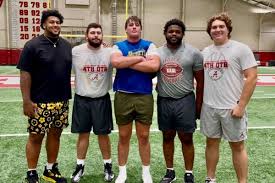For over a decade, Alabama football has been the gold standard in college football. Under legendary head coach Nick Saban, the Crimson Tide weren’t just dominant—they were dynastic. Every fall brought a new wave of five-star talent, national championship expectations, and an intimidating aura that swallowed opponents whole. But in the post-Saban era, the question isn’t whether Alabama is still good. The question is whether being “good” is enough—and more importantly, whether this 2025 season will reveal if the Tide can still be great.
The 2024 campaign gave fans a lot to process. Alabama was solid, competitive, and disciplined—but no longer unbeatable. With new leadership in place, there were flashes of brilliance, but also lapses that would have been unthinkable during the program’s peak. A late-season loss to Georgia and a narrow win over LSU showed both how close and how far the Crimson Tide were from returning to the mountaintop. Now, in 2025, every element—from quarterback play to defensive leadership—must align for Alabama to transcend “pretty good” and reclaim its place among the nation’s elite.
The most pivotal storyline heading into 2025 revolves around the quarterback position. With Jalen Milroe gone, the offense turns to a new face under center. Whether it’s redshirt sophomore Dylan Lonergan or five-star freshman Zayden Ricks, the pressure is immense. Alabama’s system has long relied on not just talent, but on poise, precision, and decision-making—qualities that take time to develop but are demanded immediately in Tuscaloosa. Whoever wins the job inherits a system with elite wideouts and a strong offensive line, but also the weight of sky-high expectations and a fanbase that won’t tolerate mediocrity.
Speaking of the offensive line, that unit could be the linchpin of Alabama’s season. The Tide bring back experience and size up front, led by junior left tackle Kadyn Proctor and senior center Seth McLaughlin. Proctor, once a five-star recruit, showed steady development in 2024 and is now a projected first-round pick. If this line can dominate in the trenches like past Alabama units, the quarterback’s burden eases considerably. Establishing the run will be vital, especially with explosive tailback Justice Haynes expected to take on a full feature role. Haynes is shifty, strong, and one of the smartest backs in the SEC. A strong season from him could change everything.
On the defensive side, there’s both excitement and concern. Alabama still recruits elite defenders, and the secondary looks particularly strong this year, with Malachi Moore returning as a super senior to anchor the back end. But the pass rush must improve. Last season, Alabama recorded the fewest sacks since 2017, a troubling statistic for a program historically known for harassing opposing quarterbacks. Defensive coordinator Travaris Robinson has promised a more aggressive approach this fall, dialing up blitzes and creative packages that should unleash edge rushers like Keon Keeley and Jihaad Campbell. If they can get to the quarterback consistently, Alabama’s defense could turn from good to game-changing.
Then there’s the matter of coaching. Head coach Kalen DeBoer enters his second year with something to prove. Taking over for a titan like Nick Saban is a near-impossible task, but DeBoer’s quiet confidence and offensive mind helped stabilize the program in 2024. This year, though, stabilization isn’t enough. DeBoer must win big games—especially on the road—and keep the locker room unified through the inevitable adversity. His biggest challenge may not be X’s and O’s, but cultural: making Alabama feel like Alabama again.
There’s also the issue of the schedule. Alabama’s 2025 slate is brutal, even by SEC standards. Road trips to LSU and Oklahoma will test the team’s composure, and home matchups against Texas and Georgia are likely to have playoff implications. The Tide cannot afford more than one slip-up, and they may need to run the table if they want to secure a top-four seed in the expanded 12-team playoff. Unlike past years, there are no guaranteed wins in this lineup. Each week will demand focus, consistency, and execution—traits Alabama has in spurts, but must display for an entire season.
And then there’s the SEC itself, stronger than ever. With the addition of Texas and Oklahoma, the conference has become even more unforgiving. Georgia continues to be the standard-bearer for physical, fundamentally sound football. LSU and Tennessee are ascending powers, and Texas seems poised to make a serious playoff push this year. In other words, “good” might get you eight or nine wins. But only “great” gets you a conference title—or a shot at a national one.
One key intangible factor is leadership. Gone are the days when the roster was full of vocal veterans who held teammates accountable at every practice. Alabama needs new leaders to step up in 2025—not just stars, but tone-setters. Players like linebacker Deontae Lawson and wide receiver Kendrick Law must become the emotional and spiritual anchors of the team. It’s one thing to have talent, another to have toughness. Championships are won in locker rooms long before they’re won on Saturdays.
Another factor to watch: how Alabama adapts to the NIL era and transfer portal. The days of stockpiling talent for years are over. Programs now have to recruit not just high schoolers, but their own roster—and others’. Alabama lost a few notable players to the portal after the 2024 season, and while the return haul was solid, there are still concerns about depth, particularly at cornerback and linebacker. DeBoer and his staff must continue evolving with the sport or risk falling behind in ways that aren’t obvious until it’s too late.
This season feels like a crossroads for the Crimson Tide. If they make the playoff and contend for a national title, it’ll serve as a validation of DeBoer’s vision and a bridge to continued success in the post-Saban era. But if Alabama falters again—losing multiple conference games or failing to reach Atlanta—it may signal a slow slide from dominance into the second tier of contenders. Not irrelevant by any means, but no longer feared. No longer the standard.
That may be the greatest challenge of all—psychological rather than strategic. Alabama used to win games before they even kicked off. Opponents saw the script, felt the pressure, and folded. That aura has faded. Teams no longer fear the Crimson Tide; they relish the opportunity to knock them off. Getting that fear factor back won’t be easy, but a dominant 2025 campaign could go a long way toward restoring it.
Still, it’s fair to wonder whether the expectations that Saban created are even realistic anymore. Can Alabama be that dominant again in a college football landscape that now includes NIL, conference expansion, and a playoff system built to produce parity? Maybe greatness today doesn’t look like it did in 2012 or 2020. Maybe a great Alabama team in 2025 is one that survives the gauntlet, battles through adversity, and finds a way to peak at the right time. Or maybe, just maybe, that old Alabama—the ruthless, machine-like juggernaut—isn’t gone. Maybe it’s just been waiting for the right spark.
That spark could be anything: a last-second win over Texas, a Heisman-caliber season from a surprise breakout star, a galvanizing moment in the locker room after a heartbreaking loss. Alabama has always responded to pressure with power. The difference now is that the rest of the country has caught up—and they’re not waiting for Alabama to figure things out.
So will Alabama be great or just good in 2025? That answer will come not just from the scoreboard, but from how this team carries itself when things get hard. The standard remains the standard, as they love to say in Tuscaloosa. But in this new era, that standard must be earned all over again. Every game. Every play. Every Saturday.
Because for Alabama, good has never been good enough.



